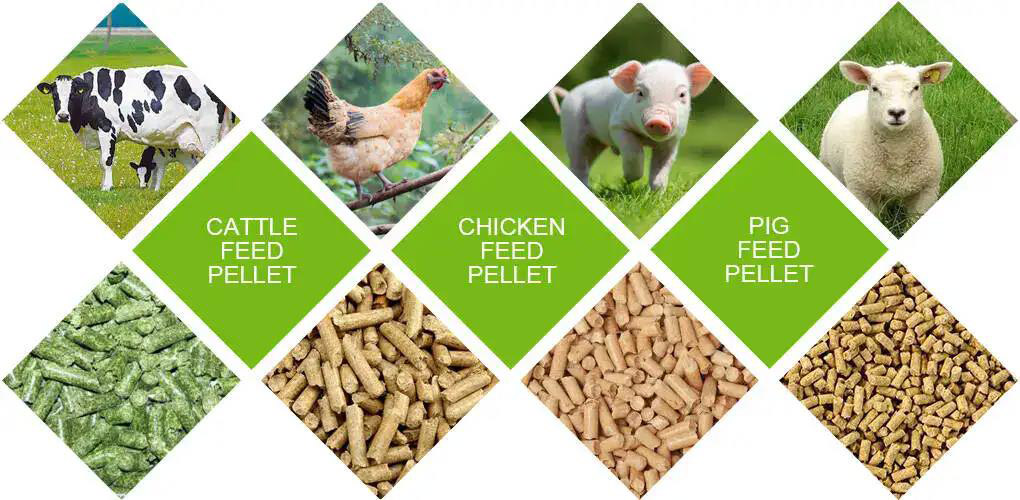large feed mill
A large feed mill is an industrial facility specializing in the production of animal feed, equipped with advanced technology and high production capacity.
large feed mill Introduction


Main Functions of a large feed mill
Feed Formulation
Designing and formulating feed recipes tailored to the nutritional requirements of different animals and stages of growth.
Raw Material Procurement and Storage
Procuring high-quality raw materials such as grains, proteins, vitamins, and minerals, and ensuring their safe storage.
Processing and Production
Using advanced equipment for grinding, mixing, pelleting, and other processes to produce uniform and nutritious feed.
Quality Control
Implementing stringent quality control measures to ensure the nutritional integrity, safety, and compliance of the feed with regulatory standards.
Packaging and Distribution
Packaging the finished feed in various formats suitable for storage, transport, and sale.
Research and Development
Conducting research to innovate and improve feed formulations, production processes, and product quality.
Environmental Management
Implementing practices to minimize environmental impact, such as waste management and energy efficiency.
Customer Support
Providing technical support, training, and assistance to customers regarding feed usage and application.


Main structure of a large feed mill
Raw material receiving and storage area
Used for receiving and storing various types of raw materials, such as grains, protein sources, vitamins, and mineral supplements, ensuring a secure and reliable supply of ingredients.
Grinding and pre-processing equipment
Includes crushers and pre-processing equipment to initially process and grind raw materials, preparing them for subsequent mixing.
Mixing equipment
Blends the crushed raw materials according to specific formulation ratios to ensure uniform distribution of nutritional components in the feed.
Pelleting and granulation equipment
Shapes the mixed raw materials into pellets or granules to enhance feed palatability and stability.
Drying equipment
Processes the pellets or granules to remove excess moisture, preventing mold and spoilage.
Packaging equipment
Standardizes the packaging of finished feed, facilitating storage, transportation, and sales.
Quality control laboratory
Conducts quality control and safety testing of raw materials and finished feed to ensure compliance with relevant regulations and standards.
Warehousing facilities
Stores finished feed products to maintain their safety and quality before distribution.
Automation control systems
Modern feed mills are typically equipped with automation control systems to monitor and adjust various stages of production, enhancing production efficiency and product quality.


Main Advantages of a large feed mill
Economies of scale
They achieve cost efficiencies in raw material procurement, equipment utilization, and transportation, lowering production costs.
Advanced technology
Equipped with advanced production equipment and automation control systems, they enhance production efficiency and ensure product quality stability.
Quality assurance
They maintain comprehensive quality control systems and laboratory testing equipment to ensure balanced nutritional content and safety of the feed.
Innovation capability
They possess strong research and development capabilities to innovate and improve feed formulations and production processes.
Stable supply
They provide reliable feed supply to meet the demands of large-scale farming operations and the pet food market.
Environmental sustainability
They adopt advanced environmental technologies and sustainable production practices to minimize resource waste and environmental impact.
Market competitiveness
They can adapt flexibly to changes in market demand, offering diverse product choices and customized services to customers.
Application of large feed mill
Typically, the production of animal feed processing plant uses raw materials such as corn, soybeans, wheat, and other nutrients as the formula. Our small feed mill plant are specially used to produce feed for poultry, livestock, pigs, horses, cattle, sheep, chickens, ducks, goose and other animals.For different animals, with different growth cycles, (chicks, suckling pigs, calves, etc.), the feed pellet size required is different, but our feed production line only needs to replace ring molds with different apertures or use a pellet crumbler to reach the required size.

Parameter of large feed mill
| Model | Capacity | Main Motor Power | Feeder Motor Power | Conditioner Power | Dia. of Ring Die | Pellet Size |
| SZLH250 | 1-2T/H | 22KW | 0.75kw | 1.5kw | 250mm | 2-12mm |
| SZLH320 | 3-4T/H | 37KW | 1.5kw | 2.2kw | 320mm | 2-12mm |
| SZLH350 | 5-7T/H | 55KW | 1.5kw | 3kw | 350mm | 2-12mm |
| SZLH420 | 8-12T/H | 110KW | 1.5kw | 7.5kw | 420mm | 2-12mm |
| SZLH508 | 10-18T/H | 160KW | 2.2kw | 11kw | 508mm | 2-12mm |
| SZLH558 | 15-25T/H | 180KW | 2.2kw | 11kw | 558mm | 2-12mm |
| SZLH678 | 20-30T/H | 220KW | 2.2kw | 11kw | 678mm | 2-12mm |
| SZLH768 | 25-42T/H | 280KW | 2.2kw | 11kw | 768mm | 2-12mm |







